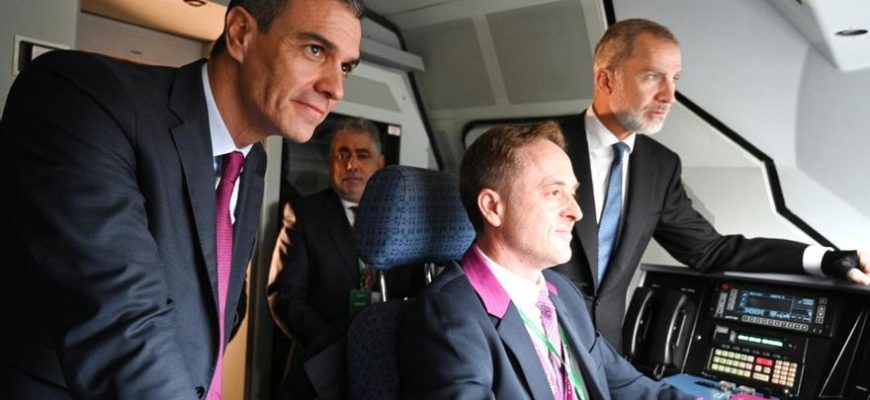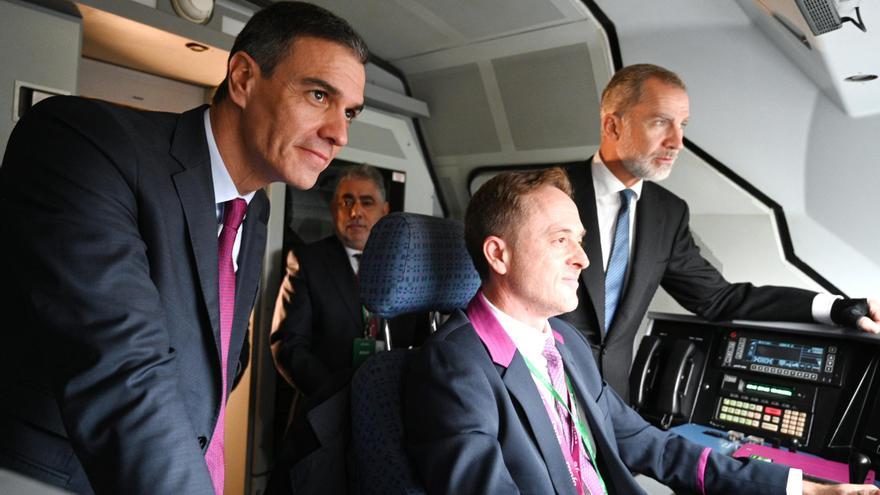At seven minutes past four in the afternoon, Alvia 10021 heads into the south mouth of the west tube of the Pajares Bypass and eleven minutes later it exits the time tunnel. The first fast train from Asturias to Madrid went up and maintained two hundred kilometers per hour, touched 201 and emerged from the darkness saying goodbye to the curves of the Pajares ramp, to the reverse journeys to León, to accidents and storms. that block the road and bus transfers. To the comings and goings of nineteen different opening dates between 2010 and 2023 and to a huge extra cost that has ended up doubling the initial investment forecast. To the waterways, to the rivers that change basins and to the slopes that threatened to fall onto the tracks. 6,713 days in construction, all the vicissitudes of nineteen long years and 4,000 million euros. The inaugural train that cut the ribbon and finally opened “an iron path” in which Pedro Sánchez also wants to see “a path of solutions to vindicate unjust isolation” made the Madrid-Oviedo journey for the first time in three hours and ten minutes and ate up the Cordillera, from La Robla to Pola de Lena, changing that hour and a half for these sixteen minutes. It is the fastest movement that can be made by land between Asturias and Madrid and in the protocol act with which the authorities almost exhausted the capacity for metaphor in Oviedo, the president, the Government ended up ruling in his own way that this ending is another principle and that this “giant leap that literally saves the Cordillera” is also understood as “a hand extended to unite territories of a country proud of its diversity”, a new beginning that opens Asturias “to new investments and opportunities”.
On board the protocol convoy the President of the Government traveled from Madrid to Oviedo with King Felipe VI and among the two hundred guests the Minister of Transport and three former ministers, as well as deputies and senators of almost every stripe and businessmen and representatives of the Asturian social, political and business life. Whether in the carriages or at the foot of the track, everyone strives to explain what exactly begins today and expands on the hopeful futuristic story of what Asturias needs to take advantage of everything that is revealed behind this open door to the future. It is the eve of the anniversary of the birth of Winston Churchill, number 149, and the reference to the “blood, sweat and tears” that made the British politician famous fits easily into the portrait of the path that the Pajares Bypass closed yesterday.
The Alvia departed from platform 21 in Chamartín five minutes late at around half past one in the afternoon and with 237 passengers in the nine cars, plus one service car, that make up the convoy. In the two that follow the locomotive, those of the “comfort” class, or former preferential class, travel the president, the King and the almost debutant Minister of Transport, Óscar Puente, together with the president of the Principality, Adrián Barbón, or his advisor of Development, Alejandro Calvo. At the León station, the president of Castilla y León, Alfonso Fernández Mañueco, joins a delegation that also includes, among others, three of the nine Ministers of Public Works who have seen the birth and growth of the work, the socialists Magdalena Álvarez and José Luis Ábalos and the popular Íñigo de la Serna, and directed from the cabin by Ángel González, a machinist who, being a native of Campomanes, has also seen all of this grow. So that everything remained at home, he ran the train under the supervision of Manuel Campomanes, also from Lens and chief engineer born in La Cobertoria.
Behind him, in the tourist class cars, come two hundred long deputies, senators, businessmen, union members and Father Ángel. The Mierense priest, founder and president of the NGO “Messengers of Peace”, left a slogan before boarding the train that perhaps the entire passage could respond to around him: “Today Asturias is truly Spain.” He, who is “one of those who traveled on those wooden trains”, experiences the trip as “a joy and a privilege”, he even takes a photo with the ticket and although no one has asked him, he specifies, he has come to bless the train.
On the day of new things, the train crew debuted today, over their uniforms, a very Spanish, navy blue gala cape, which they will wear from now on on very special occasions. The train has left one end of Chamartín, immersed in long improvement works, and will gradually eat up the known terrain of the section between Madrid and León, the only high-speed railway that travelers on the train from Madrid to Asturias have known until now. The day, gray in the capital, somewhat sunnier on the Castilian Plateau, is going to sulk as the train gains kilometers towards the north, until it becomes one of those afternoons of thick, almost impenetrable fog, in which even The Pajares ramp became a tunnel. But the passengers of this train, who today will make that journey underground, will never know what the weather is like today on the port’s old railway line. Neither them nor those who take long-distance trains starting tomorrow.
On the standard gauge track, pure AVE, of the Meseta, the train launches at the highest speed it will reach throughout the entire journey, 249 kilometers per hour. It only stops in León to pick up the delegation of guests that completes the expedition, led by Fernández Mañueco, and for the King and Pedro Sánchez to receive them and take a family photo with them.
The train has just crossed the only gauge changer on the route, just before the León station, and soon, very soon, all of this will no longer be just another trip. The two hours from Madrid to León were already here. Now, where the usual passenger mustered up the courage to face 49 kilometers of very steep ascent and descent, of 65 tunnels and no more than 75 kilometers per hour, the mouth of a large tunnel emerges that puts Campomanes at an unusual sixteen minutes from La Robla. Because they are who they are, the passengers of this special train watched the passage through the 25 kilometers of the Variant’s main tube through a screen that tells everything in real time. Installed in the front of the locomotive, it retransmitted the moment in all the cars, although the service was, in principle, only for yesterday. It will not be maintained. On the railway route from Asturias to Madrid everything will be much more conventional in these first days of the Variant, at least until in the first quarter of next year, and possibly in February, the long-awaited “Avril” trains are presented on the line, Renfe’s high-speed and movable wheels, with their increase in comfort features and attention on board.
At the moment, yesterday, the seventh longest tunnel in Europe, as they were responsible for advertising a screen at the entrance to the platform, others inside the carriages and the enormous monitor that presided over the tent installed at the Oviedo station, took place yesterday. to Asturias from isolation in eleven minutes. While this was happening outside, in the carriages the debate that Asturias has had open for months about what to do with high-speed trains was lengthening. The expressive way of speaking of the business representatives leaves no room for doubt about the need to “put the machinery in motion,” summarizes the president of the Oviedo Chamber of Commerce, Carlos Paniceres.
He talks about frequencies, prices, Renfe’s low-cost trains, activating “all possible mechanisms so that this infrastructure has an economic return”, and announces, among many others, a joint promotion strategy for the ski resorts of Asturias. and Leon.
His counterpart from Avilés asks that the single daily frequency planned from Villa del Adelantado be doubled “at least.” Here we talk in split time about celebrations, about hopes and strategies for making the most of things, about the time that has passed and about what has to happen… “There will be a before and an after,” says confidently Magdalena Álvarez, the minister under whose distant mandate (2004-2008) the rock was opened to allow the passage of the tunnel boring machines. The popular Íñigo de la Serna (2016-2018) sees the “starting point for a horizon of hope in a better future for Asturias” and José Luis Ábalos (2018-2021), returning to the turbulent past of this very changing work, reflects about the fluctuations in opening dates and admits that although “if I was wrong, it was because I listened to the technicians”, throughout history there were also “many opening dates conditioned by political or electoral interest.”
Ábalos has passed the time by visiting the Asturian representative Adriana Lastra, who travels three cars behind his own, and confesses that, although he was minister for nearly three years, this is the first grand inauguration event he has attended. “I didn’t want to,” he says. The passengers have received a frugal lunch based on sausages, cheeses, smoked meats and fruit, and the train has swallowed the kilometers at a speed that surprises more the Asturians who know the Pajares ramp than the foreigners not accustomed to passing through the old nineteenth-century layout.
Everything slows down from Pola de Lena, the speed drops to less than one hundred, Ujo and Mieres pass and, suddenly, at a quarter to five in the afternoon, just three hours and ten minutes after the departure, the start is announced. Oviedo station.
The great institutional act that follows delves into the metaphor of what it means to have overcome the resistance of the mountain and the benefits that await on the other side of the tunnels. In a tent presided over by a huge screen, the Minister of Public Works, Óscar Puente, whom the presenter mistakenly calls Carlos, speaks; the presidents of the Principality and Castilla y León and the president of the Government. They were greeted by bagpipes and a protest focused on Pedro Sánchez whose echoes, including the national anthem, filtered into the tent.
The head of the Executive refused to look for excuses for the delays, Adrián Barbón expressed his “gratitude to the State” for the opening of the tunnels and the “breaking of a mental fence that has gripped us” in a long time of “secular isolation” and its Castilian-Leonese colleague, Alfonso Fernández Mañueco, the only representation of the PP among socialist leaders, celebrated that “the doors of the future are opening to us” before sneaking in a slight mention of the cohesion, equality and freedom of all Spaniards. “Puente reviewed” an unprecedented challenge that makes the transition from “the 19th to the 21st century in one fell swoop” and saw the arrival of “more job opportunities for citizens” and “more incentives for businesses and tourism” with the trains.
A “career award” and full of Lenenses in the Alvia cabin
Manuel Campomanes “didn’t think” he was going to get it, but the share of prominence he assumed yesterday at the premiere of the Variante de Pajares could well serve as the “prize for a career.” Head of train drivers at Renfe, sixty years old and born in La Cobertoria (Lena), he is a “son of the railway” who did not expect to be elected – “many people want to enjoy this” – but who yesterday was able to collaborate in the railway plenary session Lenenses in the cabin of the first Alvia of the Variante. He shared it with Ángel González, a natural driver from Campomanes, whom he supervised during the tour. Campomanes and González received a visit from King Felipe VI and the rest of the great authorities who were traveling in the inaugural convoy of the Asturian high-speed route. The two will go down in history in the photographs of the route that symbolizes the opening of the most complex railway project ever undertaken in Spain.








